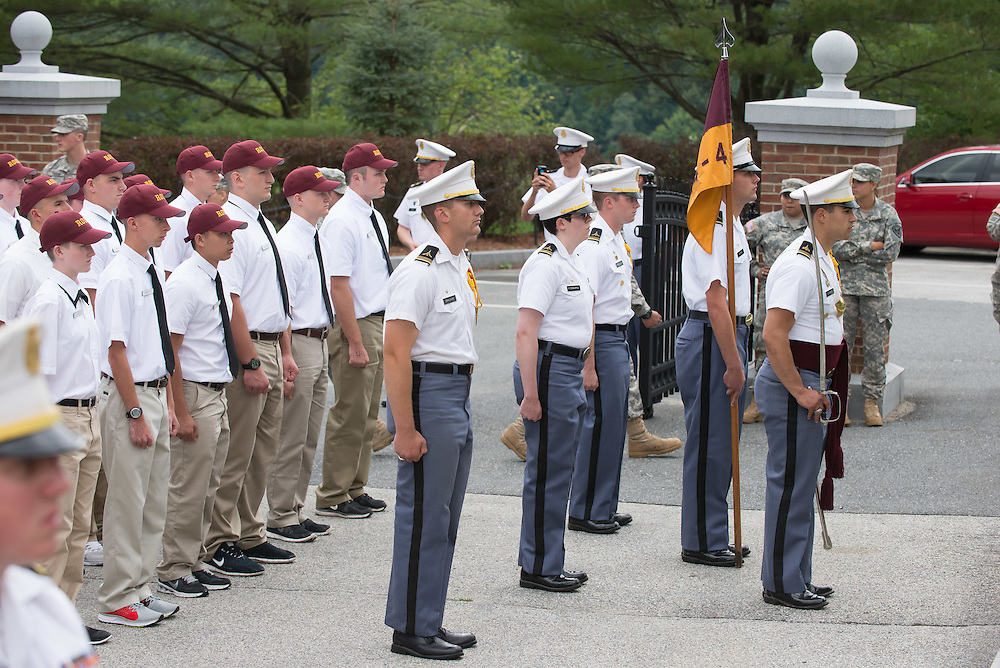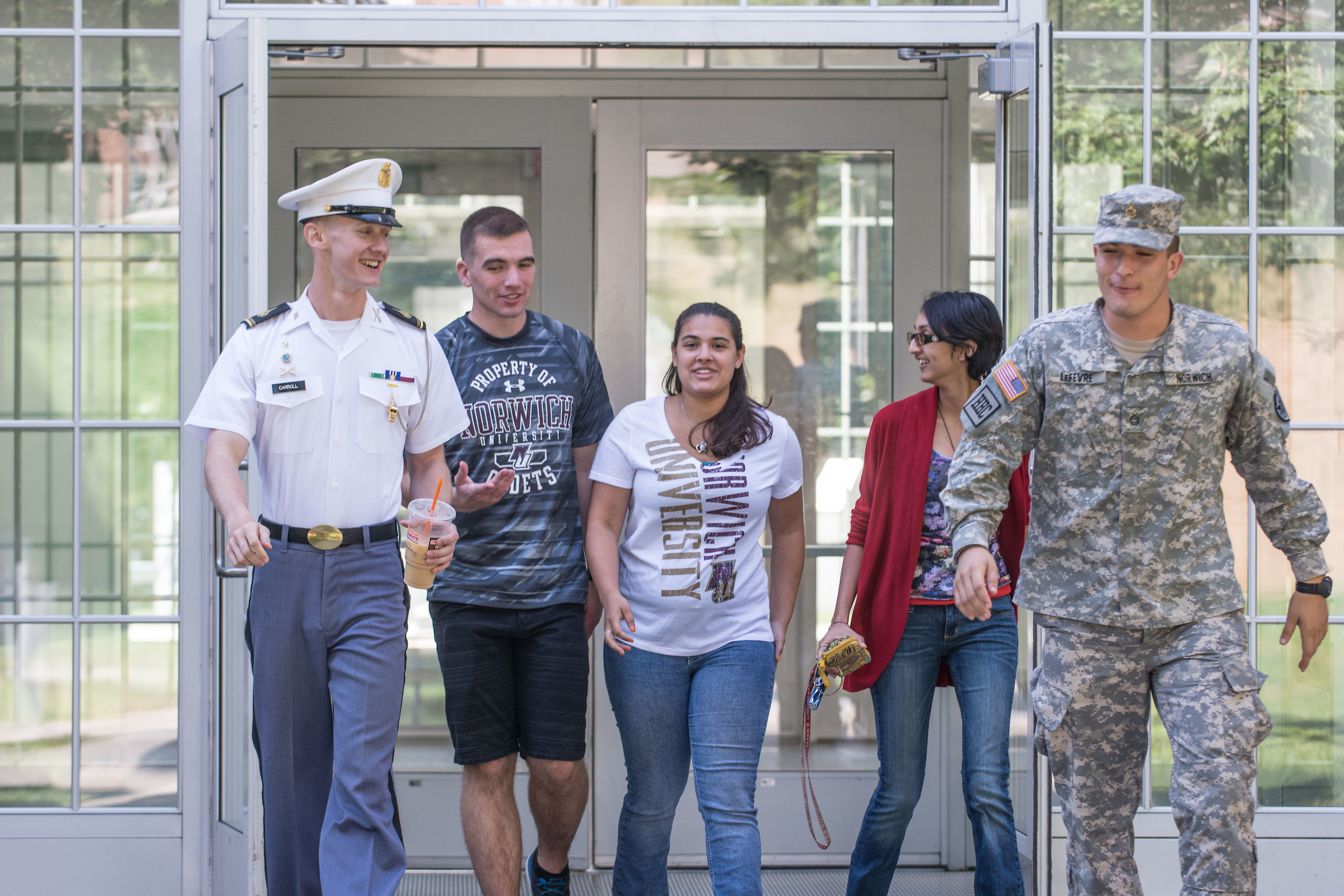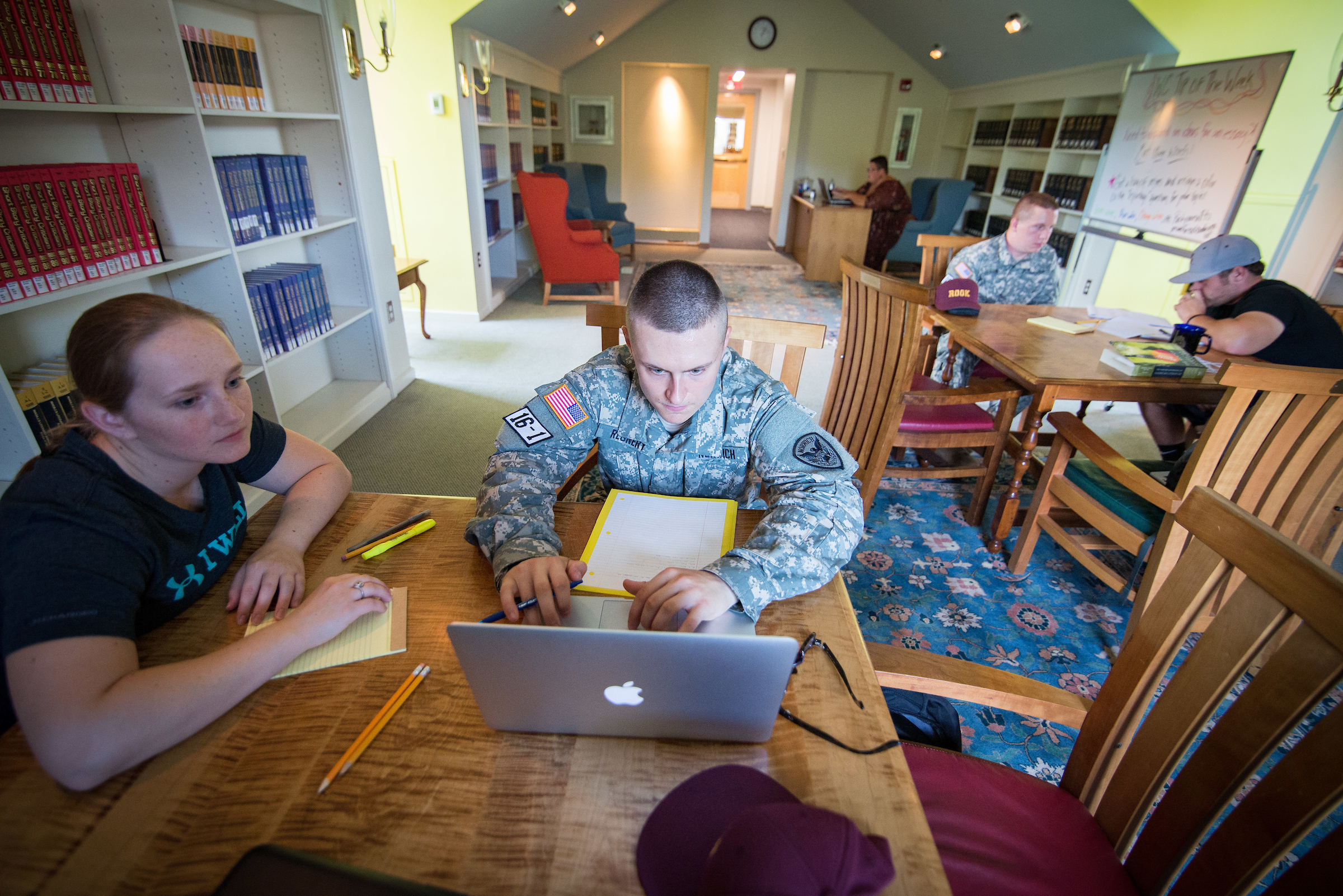Dalyn Luedtke, Norwich University
Every fall Norwich University, the oldest private senior military college in the United States, looks much like any other campus, which is to say that it is teeming with excited, slightly anxious freshman—except that 2/3 of the school’s approximately 800 freshmen are rooks. Freshmen in Norwich University’s Corps of Cadets (the rooks) undergo the rigorous demands of rookdom, which is the training that assimilates them into the culture and expectations of the Corps. From an outsider’s perspective, what stands out most about their experience is the matching uniforms with baseball caps labeled with the word ‘rook;’ the way they walk in the gutters making only 90 degree turns as they cross campus; the way they eat at attention, backs not touching their chairs and neither looking nor speaking to one another, in the chow hall; the way they stand at attention waiting to be told to sit down or when to speak; and, the common sight of a tardy rook getting dressed down by a superior in the middle of campus for the failure to successfully complete any number of tasks. The demands, which are in addition to typical academic demands, are meant to build discipline, break down differences between individuals to create a team, and teach them how to successfully function in a stressful environment.

Within this culture of uniformity and hierarchy, we opened Norwich University’s first writing center, the Center for Writing, in Fall 2016. About 2/3 of the student population is in the Corps of Cadets. which is nearly identical to the demographics of our peer tutors. As a result, one of the first decisions we had to make was whether to abide by the uniform policy as described in the Corps of Cadets’ Standard Operating Procedures or craft a separate “uniform policy” for our staff. Because the Center was developed and promoted as a place for peer-to-peer collaboration around writing, the presence of tutors in uniform (including the Director) immediately raised questions about how it might affect the Center as a collaborative space and reinforce power structures that exist at the university outside of the center. These questions and their answers, which we continue to grapple with, are at the heart of our rationale for discouraging uniforms for the peer tutors in our center while also continually assessing how to mitigate my presence, as the Director and an Associate Professor of English, in uniform. While our situation is very specific to our context, our experience defining the Center’s dress code clearly illustrates the ways in which dress codes reinforce hierarchies, and therefore behavior, and highlights how writing centers’ dress codes might reconfigure the position of a writing center and its community members.
The Norwich Community: Who Wears the Uniform?
Norwich University does not have one uniform policy that applies to all members of our community, but the Corps of Cadets makes up the largest group on campus and is also the most visible because of the Corps uniform. Once rooks are recognized in the spring semester, they join the ranks of the Corps, where they are expected to “wear the Uniform of the Day (UOD) every day from first call until directly after consuming the evening meal. This includes daily formations, academic classes, final exams (day or night), in academic buildings or the dining facility, on the Upper Parade Field (UP), between reveille and retreat on weekends and as prescribed by the Commandant and Regimental Commander” (“Standard Operating Procedures” 45). The Uniform of the Day is such a mainstay of cadet life that many cadets jump at the opportunity to adopt business dress for class presentations and even pay to be out of uniform for a day as part of an annual fundraiser. That said, the uniform is commonly understood by members of the Corps as one method of creating uniformity and enhancing cohesion among their members, but it is also used as the primary method of quickly identifying rank, which in turn dictates the level of decorum expected in their interactions.
Students who choose the civilian lifestyle, on the other hand, make up about 1/3 of the population. That group predominantly consists of athletes, commuters, veterans, and family members of faculty and staff. Norwich began accepting civilian students through the acquisition of Vermont College in the 1970s, but the Corps and civilian populations did not live on the same campus until 1994. Since then, civilian numbers have been steadily increasing. That said, there is still considerable separation between the Corps and civilian students which leads many to question why a non-Corps student would even consider Norwich—the civilian student FAQ page on the website even leads with the question, “Why should I attend Norwich as a civilian student?” One of our Corps tutors, who I interviewed about our uniform policy, explains the relationship between the student populations eloquently, noting some of the reasons for the divide: “If you step into a classroom, the Corps population is typically the majority, and that in itself can be intimidating to civilian students. The freshmen Corps students bond over their experiences, and it can be difficult for them to relate to civilian students and vice versa. There is an invisible barrier that some civilian students see between themselves and Corps students.” What is particularly insightful about this tutor’s observation is that she identifies how successful the Corps is at creating camaraderie amongst its members. The forced marches and early morning PT and living together in barracks are a large part of that team-building—and the uniform puts that camaraderie on display.

Like the students, faculty and staff also have different requirements when it comes to being in uniform. Because of Norwich University’s history with the Vermont State Militia (VSM), it has a tradition of requiring tenured/tenure-track faculty to be uniformed, even those without any military background. Uniformed faculty are expected to “uphold the rich heritage and tradition behind the wearing of the uniform. This means that each uniformed member of the faculty and staff must present a neat, clean, professional military appearance. The uniform must fit and be worn properly […]. Grooming standards must present a neat, conservative military appearance” (Schneider 1). Uniformed faculty wear the retired United States Army uniform, which has been adapted for VSM use, and they also wear military insignia that correlate to their academic rank: Assistant Professor, Major; Associate Professor, Lieutenant Colonel; and Professor, Colonel. Additionally, wearing the military uniform requires specific social courtesies, such as saluting, and grooming habits, such as being clean-shaven and wearing minimal jewelry. Because of the demands of the uniform and its attendant habits, there are some exceptions. For instance, tenured/tenure-track faculty can be exempted from the uniform in cases of pregnancy, injury, or disability. Contingent faculty are not required to wear the uniform at all. While many faculty view the uniform as a positive part of the tradition of Norwich, there is concern that it reinforces hierarchies among tenured/tenure-track and non-tenure-track faculty and that it inadvertently but obviously calls out gender and ability.
Subsequently, it is not an understatement to say that the uniform works to define Norwich University as a place, “an instantaneous configuration of positions” (de Certeau 117). In his discussions of place and space, de Certeau contrasts the order and stability that defines place with the dynamic elements of space, or ‘practiced place.’ Place neatly encompasses how Norwich sees itself. The military practices of the Corps make that vision apparent to the community and the world outside of Norwich. It is often a source of pride that even our civilian students pick up the social courtesies expected of cadets. But, the uniform, with its clear communication of tradition and rank, is a foundational element upon which the administrative structures of the university are built. Tradition, with its clear implication of timelessness, is what unites much, but not all, of the Norwich community.
Creating a ‘Space’ for Writing
The creation of the Center for Writing, however, challenges the notion of tradition in a few significant ways, not least of which is that the development of the center broke a long-standing tradition of all writing support being offered by professional tutors in the Academic Achievement Center. There had been significant resistance to the concept of peer tutoring in writing for many years, although Norwich long had peer subject tutors, because of concerns about ethics and the ability of peer tutors to support writing across disciplines. Advocating for peer tutors was sometimes perceived as saying, “students can provide the same/as good as writing support as professionals” even though they do not have the experience or disciplinary knowledge. The reliance on professional tutors, many of whom were also instructors, comfortably fit within the ranks of teaching at Norwich.
Furthermore, in the proposal, the Center for Writing was conceived of as a “space that foregrounds collaboration,” which provides “a method and space for the production of shared knowledge in a scholarly setting.” By creating a space for collaboration and the production of shared knowledge, the Center for Writing, and the writing center theories that inform it, becomes a microcosm for the tensions that can exist between academic and military cultures. In The Practice of Everday Life, Michel de Certeau argues that “Space occurs as the effect produced by the operations that orient it, situate it, temporalize it, make it function in a polyvalent unity of conflictual programs or contractual proximities” (117). The activities that define the center start with the student writer, who enters our space at some point in the writing process. In fact, the very focus on process is transformative and challenging itself, as the writing process is so often not linear, jumping around in time, argument, and research. The “operations that orient” our center are defined by one-on-one, peer-to-peer interaction but also include sending writing tutors into classrooms, such as our Criminal Justice Senior Seminar, to bring collaborative support to the site of instruction, sharing meals during professional development, creating Valentines as a means of outreach, and a wide variety of other operations that make our center a distinct, unique space on campus. Through these activities and our conscious, active invitation to welcome all the writers of Norwich, we seek to create a collaborative space that enacts de Certeau’s “polyvalent unity.”
Our of Regs
Much of the writing center literature strongly advocates for the benefits of collaborative learning and frames the relationship between peer tutors and writers as such (Bruffee; Lerner; Trimbur and Kail). In fact, the writing center acts as a space that resists the structure of a typical classroom where the site of knowledge rests with the instructor at the front of the class. Instead, the tutor is positioned as a welcoming companion in the writing process and that spirit of welcoming, of openness, is communicated by centers physically in a variety of ways including floor layouts, furniture choices, plants, artwork, etc. As I created the Center for Writing last fall, I carefully made all these decisions in an effort to craft a specific ethos. I also made one more. I felt that the uniform was antithetical to the center as a collaborative space. So, I asked our tutors who are in the Corps to leave their uniform in the barracks when they work in the center if at all possible. It is important to note that I do not require civilian dress nor are they technically ‘out of regs’ given that most Corps tutors work evening hours. But, because many of the students who visit the Center are rooks who have been conditioned to take orders and we often employ cadre who are their superiors, civilian clothing, to my mind, means being free from the assumptions and expectations that go with the uniform.

Unsurprisingly, some of our tutors disagreed. Several of our Corps tutors do not think the uniform impacts their relationships with the writers who come to the Center. When I initially broached the idea of wearing civilian clothing, they insisted that they were able to effectively move from role of cadre to that of writing tutor without a problem. I agreed. Indeed, that is why I hired them. Writing tutors, in my experience, not only bring writing expertise to the table but also the ability to effectively engage with other people in ways that put them at ease in even the most challenging of situations. These Corps tutors are no different (and, arguably, their leadership experience in the Corps enhances that ability). My concern was, and still is, that freshmen, who in the first year made up 76% of our clients, would, in the case of rooks, be unable to differentiate the conversation they have with tutors from the orders they receive from their superiors. I experience this every day in the fall semester in my composition classes as I try to engage rooks in discussion about their ideas but have to struggle to get more than a “yes, ma’am,” and we see it regularly in the Center before rooks are recognized. While many tutors approach sessions by asking questions, rooks are often uncomfortable stating their ideas because in their Corps life they are being taught to follow directions not ask questions. The uniform of a superior, and everyone is superior to a rook, is the source of that training and anxiety. For civilian freshmen, who are still ignorant of how the Corps works, the uniform is the “invisible barrier” that our tutor identified above. Though I made the decision about our dress code in the center, I consulted with our tutors, considering their more extensive experience with it, and I continue to talk to them about the impact it has on the Center. So far, the overall impression from both civilian and Corps students is positive. In fact, when asked about their experience out of uniform in the center, one tutor notes, “Removing the uniform from the equation makes the interaction more human and brings a level of sincerity to the table. [It] helps to focus more on the task at hand and spend more time on what it really important – improving their writing!”
Conclusion
In other words, if the writing center is meant to resist or upend the typical power structure of the classroom, then the uniform complicates that agenda by focusing the power back to the one who is marked by the pins on their chest or their position at the head of the classroom. While we wear our rank on our shoulders and chest, which makes our situation fairly unique, the dynamics created by uniforms and dress codes in the workplace have implications for professional dress more broadly conceived. When writing centers consider dress codes—whether it be a common t-shirt, business casual, or the Uniform of the Day—it is useful to consider both how they help create community and also how they create insiders and outsiders and erase individual identity, which is a notion antithetical to the work of centers. We engage in work that honors individual ideas and nurturing voice in all writers. The most important lesson we have learned in this process is that what we wear can create opportunities to redistribute the center of expertise in tangible, productive ways.
References
Bruffee, Kenneth. (1984). Collaborative Learning and the “Conversation of Mankind.” College English, 46(7), 635-52.
de Certeau, Michel. (1984). The Practice of Everyday Life. University of California Press.
Kail, Harvey, & John Trimbur. (1987). The Politics of Peer Tutoring. WPA: Writing Program Administration, 11(1-2), 5-12.
Lerner, Neal. (2016). What is the Writing Center? A Rhetoric for Writing Program Administrators, Edited by Rita Malenczyk. Parlor Press.
Norwich University Corps of Cadets. (2015, Aug.). Standard Operating Procedures.
Schneider, Richard. (2010, Feb.) Letter of Promulgation. Staff and Faculty Uniform Manual.
